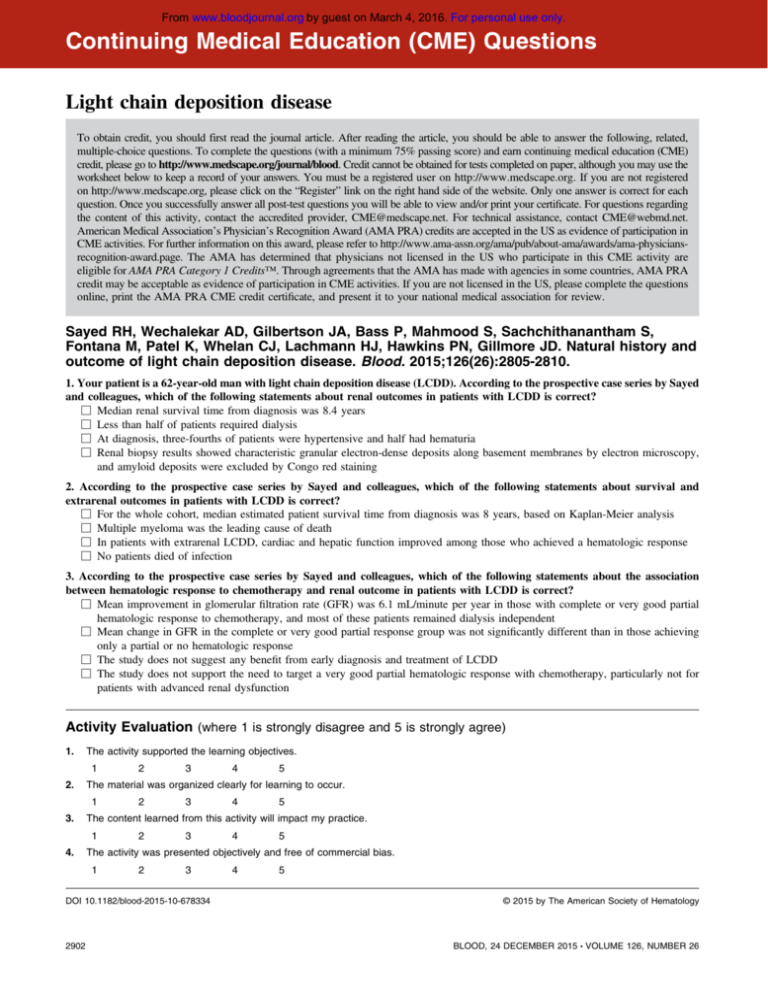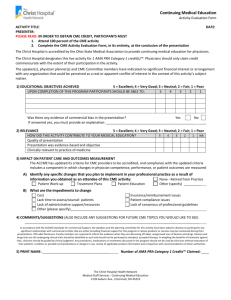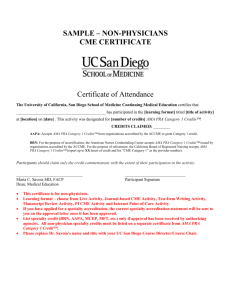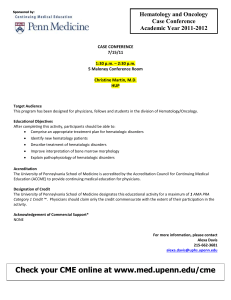
From www.bloodjournal.org by guest on March 4, 2016. For personal use only.
Continuing Medical Education (CME) Questions
Light chain deposition disease
To obtain credit, you should first read the journal article. After reading the article, you should be able to answer the following, related,
multiple-choice questions. To complete the questions (with a minimum 75% passing score) and earn continuing medical education (CME)
credit, please go to http://www.medscape.org/journal/blood. Credit cannot be obtained for tests completed on paper, although you may use the
worksheet below to keep a record of your answers. You must be a registered user on http://www.medscape.org. If you are not registered
on http://www.medscape.org, please click on the “Register” link on the right hand side of the website. Only one answer is correct for each
question. Once you successfully answer all post-test questions you will be able to view and/or print your certificate. For questions regarding
the content of this activity, contact the accredited provider, CME@medscape.net. For technical assistance, contact CME@webmd.net.
American Medical Association’s Physician’s Recognition Award (AMA PRA) credits are accepted in the US as evidence of participation in
CME activities. For further information on this award, please refer to http://www.ama-assn.org/ama/pub/about-ama/awards/ama-physiciansrecognition-award.page. The AMA has determined that physicians not licensed in the US who participate in this CME activity are
eligible for AMA PRA Category 1 Credits™. Through agreements that the AMA has made with agencies in some countries, AMA PRA
credit may be acceptable as evidence of participation in CME activities. If you are not licensed in the US, please complete the questions
online, print the AMA PRA CME credit certificate, and present it to your national medical association for review.
Sayed RH, Wechalekar AD, Gilbertson JA, Bass P, Mahmood S, Sachchithanantham S,
Fontana M, Patel K, Whelan CJ, Lachmann HJ, Hawkins PN, Gillmore JD. Natural history and
outcome of light chain deposition disease. Blood. 2015;126(26):2805-2810.
1. Your patient is a 62-year-old man with light chain deposition disease (LCDD). According to the prospective case series by Sayed
and colleagues, which of the following statements about renal outcomes in patients with LCDD is correct?
M Median renal survival time from diagnosis was 8.4 years
M Less than half of patients required dialysis
M At diagnosis, three-fourths of patients were hypertensive and half had hematuria
M Renal biopsy results showed characteristic granular electron-dense deposits along basement membranes by electron microscopy,
and amyloid deposits were excluded by Congo red staining
2. According to the prospective case series by Sayed and colleagues, which of the following statements about survival and
extrarenal outcomes in patients with LCDD is correct?
M For the whole cohort, median estimated patient survival time from diagnosis was 8 years, based on Kaplan-Meier analysis
M Multiple myeloma was the leading cause of death
M In patients with extrarenal LCDD, cardiac and hepatic function improved among those who achieved a hematologic response
M No patients died of infection
3. According to the prospective case series by Sayed and colleagues, which of the following statements about the association
between hematologic response to chemotherapy and renal outcome in patients with LCDD is correct?
M Mean improvement in glomerular filtration rate (GFR) was 6.1 mL/minute per year in those with complete or very good partial
hematologic response to chemotherapy, and most of these patients remained dialysis independent
M Mean change in GFR in the complete or very good partial response group was not significantly different than in those achieving
only a partial or no hematologic response
M The study does not suggest any benefit from early diagnosis and treatment of LCDD
M The study does not support the need to target a very good partial hematologic response with chemotherapy, particularly not for
patients with advanced renal dysfunction
Activity Evaluation (where 1 is strongly disagree and 5 is strongly agree)
1.
The activity supported the learning objectives.
2.
The material was organized clearly for learning to occur.
3.
The content learned from this activity will impact my practice.
4.
The activity was presented objectively and free of commercial bias.
1
1
1
1
2
2
2
2
3
3
3
3
DOI 10.1182/blood-2015-10-678334
2902
4
4
4
4
5
5
5
5
© 2015 by The American Society of Hematology
BLOOD, 24 DECEMBER 2015 x VOLUME 126, NUMBER 26
From www.bloodjournal.org by guest on March 4, 2016. For personal use only.
2015 126: 2902
doi:10.1182/blood-2015-10-678334
Light chain deposition disease
Updated information and services can be found at:
http://www.bloodjournal.org/content/126/26/2902.citation.full.html
Articles on similar topics can be found in the following Blood collections
CME article (144 articles)
Free Research Articles (3658 articles)
Information about reproducing this article in parts or in its entirety may be found online at:
http://www.bloodjournal.org/site/misc/rights.xhtml#repub_requests
Information about ordering reprints may be found online at:
http://www.bloodjournal.org/site/misc/rights.xhtml#reprints
Information about subscriptions and ASH membership may be found online at:
http://www.bloodjournal.org/site/subscriptions/index.xhtml
Blood (print ISSN 0006-4971, online ISSN 1528-0020), is published weekly by the American Society
of Hematology, 2021 L St, NW, Suite 900, Washington DC 20036.
Copyright 2011 by The American Society of Hematology; all rights reserved.








